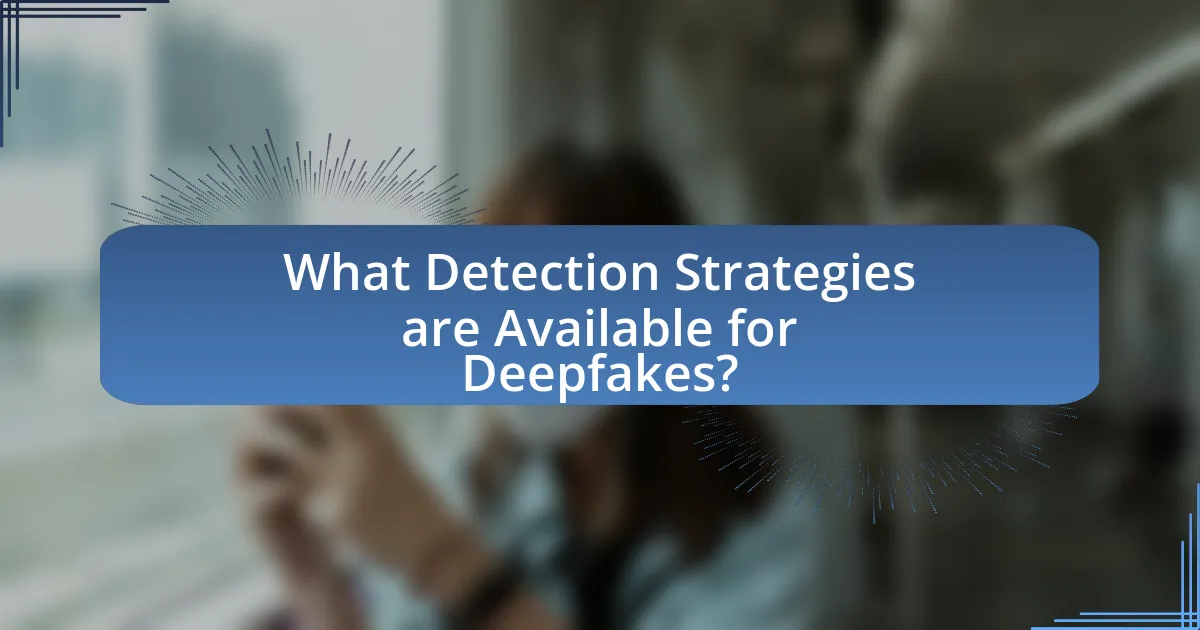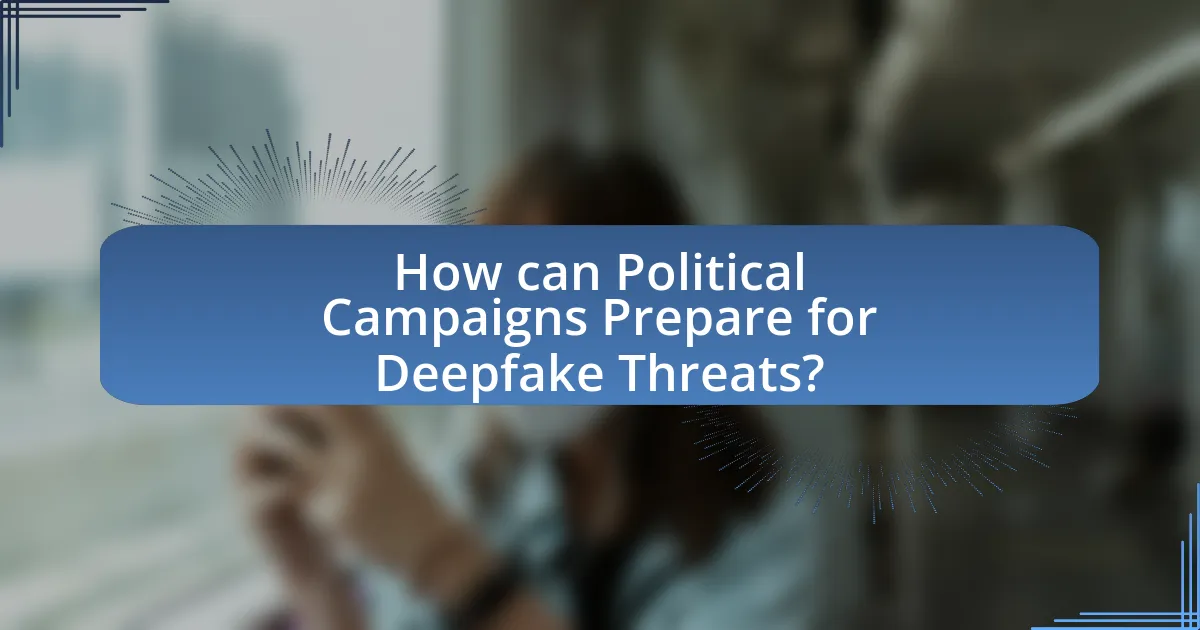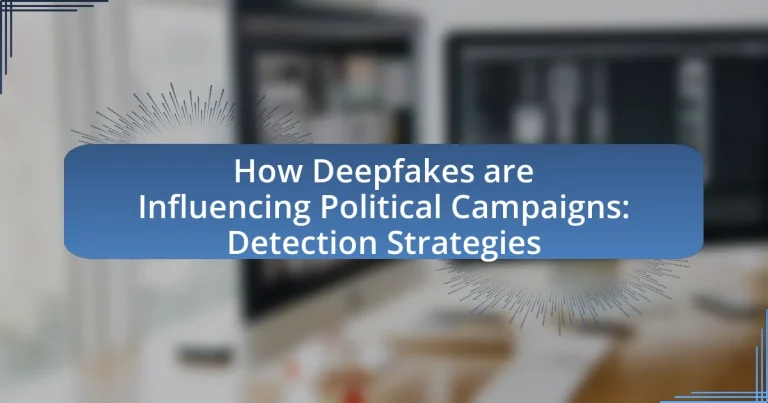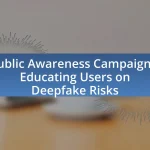Deepfakes are increasingly influencing political campaigns by creating misleading content that distorts public perception and undermines trust in political figures. This article examines the characteristics of deepfakes, their impact on voter behavior, and the challenges they pose to electoral integrity. It also explores detection strategies, including machine learning algorithms and digital forensics, as well as the role of social media platforms in combating deepfake misinformation. Additionally, the article outlines proactive measures that political campaigns can adopt to prepare for and respond to deepfake threats, ensuring the integrity of political discourse.

How are Deepfakes Impacting Political Campaigns?
Deepfakes are significantly impacting political campaigns by enabling the creation of misleading and manipulative content that can distort public perception. These synthetic media can portray candidates saying or doing things they never actually did, which can lead to misinformation and erosion of trust in political discourse. For instance, a study by the University of California, Berkeley, found that deepfake videos can sway voter opinions by creating false narratives, thereby influencing election outcomes. The potential for deepfakes to spread rapidly on social media platforms further amplifies their impact, as seen during the 2020 U.S. presidential election, where manipulated videos circulated widely, raising concerns about their effect on voter behavior and decision-making.
What are the key characteristics of Deepfakes in politics?
Deepfakes in politics are characterized by their ability to create hyper-realistic audio and video content that can misrepresent individuals, often leading to misinformation and manipulation. These digital forgeries utilize advanced artificial intelligence techniques, particularly deep learning algorithms, to generate content that can convincingly mimic the appearance and voice of political figures. The potential for deepfakes to influence public perception is significant, as they can be used to fabricate statements or actions that never occurred, thereby undermining trust in media and political institutions. Research indicates that deepfakes can sway voter opinions and alter the dynamics of political campaigns, as evidenced by instances where manipulated videos have gone viral, impacting electoral outcomes.
How do Deepfakes manipulate public perception during campaigns?
Deepfakes manipulate public perception during campaigns by creating realistic but fabricated videos that can misrepresent candidates or their positions. These altered media can spread misinformation rapidly, influencing voter opinions and potentially swaying election outcomes. For instance, a study by the University of California, Berkeley, found that deepfake videos can significantly alter viewers’ perceptions of political figures, with 70% of participants believing a deepfake was real. This demonstrates the power of deepfakes in shaping narratives and undermining trust in authentic media.
What types of Deepfake content are most commonly used in political contexts?
The most commonly used types of Deepfake content in political contexts include manipulated videos of politicians making false statements, altered speeches, and fabricated endorsements. These types of content are often created to mislead voters, damage reputations, or influence public opinion during elections. For instance, a study by the University of California, Berkeley, found that Deepfakes can significantly impact the perception of political figures, with altered videos being shared widely on social media platforms, thereby amplifying misinformation.
Why are Deepfakes a concern for electoral integrity?
Deepfakes are a concern for electoral integrity because they can be used to create misleading or false representations of candidates, potentially influencing voter perceptions and decisions. The manipulation of video and audio content can lead to the spread of disinformation, undermining trust in the electoral process. For instance, a study by the University of California, Berkeley, found that deepfake videos can significantly alter viewers’ opinions about political figures, demonstrating their potential to sway elections. This capability poses a direct threat to the authenticity of political discourse and the democratic process.
What historical examples illustrate the impact of Deepfakes on elections?
Historical examples illustrating the impact of Deepfakes on elections include the 2020 U.S. presidential election, where manipulated videos of candidates circulated on social media, misleading voters. One notable instance involved a Deepfake video of House Speaker Nancy Pelosi that altered her speech to make her appear intoxicated, which was widely shared and contributed to misinformation. Additionally, during the 2019 Indian general elections, Deepfake technology was used to create fake videos of political leaders, influencing public perception and voter behavior. These examples demonstrate how Deepfakes can distort reality and affect electoral outcomes by spreading false information.
How do Deepfakes contribute to misinformation and disinformation?
Deepfakes contribute to misinformation and disinformation by creating hyper-realistic but fabricated audio and video content that can mislead viewers. This technology enables the manipulation of public figures’ appearances and statements, making it difficult for audiences to discern truth from fiction. For instance, a study by the University of California, Berkeley, found that deepfake videos can significantly alter viewers’ perceptions, leading to the spread of false narratives, especially during political campaigns. The ease of sharing such content on social media platforms amplifies its reach, further complicating efforts to combat misinformation.
What are the potential consequences of Deepfakes on voter behavior?
Deepfakes can significantly distort voter behavior by spreading misinformation and eroding trust in political figures. The manipulation of video and audio content can create false narratives that mislead voters about candidates’ positions or actions, potentially swaying public opinion based on fabricated evidence. Research indicates that exposure to deepfake content can lead to decreased trust in media and increased skepticism towards legitimate political communications, as evidenced by a study published in the journal “Nature Communications,” which found that individuals exposed to deepfakes were more likely to doubt the authenticity of real videos. This erosion of trust can ultimately affect voter turnout and decision-making, as individuals may become disillusioned with the electoral process.
How do Deepfakes affect trust in political candidates?
Deepfakes significantly undermine trust in political candidates by creating misleading representations that can distort public perception. Research indicates that exposure to deepfake content can lead to skepticism about the authenticity of candidates’ statements and actions, as evidenced by a study published in the journal “Nature Communications,” which found that individuals exposed to manipulated videos were more likely to doubt the credibility of the subjects depicted. This erosion of trust can have profound implications for electoral outcomes, as voters may become increasingly uncertain about whom to believe, ultimately affecting their voting decisions.
What role do Deepfakes play in shaping political narratives?
Deepfakes significantly influence political narratives by creating realistic but fabricated audio and video content that can mislead the public. These manipulated media can distort facts, alter perceptions of political figures, and sway voter opinions, as evidenced by instances where deepfakes have been used to spread misinformation during elections. For example, a deepfake video of a political leader can falsely portray them making controversial statements, thereby impacting their reputation and electoral prospects. The potential for deepfakes to undermine trust in authentic media further complicates the political landscape, as voters may struggle to discern truth from deception.

What Detection Strategies are Available for Deepfakes?
Detection strategies for deepfakes include machine learning algorithms, digital forensics techniques, and visual artifact detection. Machine learning algorithms, such as convolutional neural networks, analyze patterns in video and audio data to identify inconsistencies typical of deepfakes. Digital forensics techniques examine metadata and file structures to uncover alterations made to original content. Visual artifact detection focuses on identifying anomalies in facial movements, lighting inconsistencies, and unnatural audio synchronization, which are common in deepfake videos. Research has shown that these methods can achieve high accuracy rates, with some algorithms reaching over 90% in identifying manipulated content.
How do current technologies detect Deepfakes?
Current technologies detect Deepfakes primarily through machine learning algorithms that analyze inconsistencies in visual and audio data. These algorithms, such as convolutional neural networks (CNNs), are trained on large datasets of authentic and manipulated media to identify subtle artifacts that are often present in Deepfakes, such as unnatural facial movements or mismatched audio-visual synchronization. For instance, a study published in 2020 by the University of California, Berkeley, demonstrated that CNNs could achieve over 90% accuracy in distinguishing between real and Deepfake videos by focusing on these discrepancies.
What are the most effective algorithms used in Deepfake detection?
The most effective algorithms used in Deepfake detection include convolutional neural networks (CNNs), recurrent neural networks (RNNs), and generative adversarial networks (GANs). CNNs are particularly effective due to their ability to analyze spatial hierarchies in images, making them suitable for identifying subtle artifacts in manipulated videos. RNNs, especially when combined with long short-term memory (LSTM) units, excel in analyzing temporal sequences, which helps in detecting inconsistencies in video frames over time. GANs can also be utilized in detection by training a discriminator to differentiate between real and fake content, enhancing the model’s ability to recognize Deepfakes. Research has shown that these algorithms, when trained on large datasets of both real and fake videos, significantly improve detection accuracy, with some models achieving over 90% accuracy in identifying Deepfakes.
How do machine learning techniques enhance detection capabilities?
Machine learning techniques enhance detection capabilities by enabling systems to identify patterns and anomalies in data more effectively than traditional methods. These techniques, such as neural networks and support vector machines, can analyze vast amounts of data, learning from examples to improve accuracy over time. For instance, a study by Korshunov and Marcel (2018) demonstrated that deep learning models could achieve over 90% accuracy in detecting deepfake videos, significantly outperforming conventional detection methods. This ability to adapt and learn from new data allows machine learning systems to stay ahead of evolving threats, making them crucial in the fight against misinformation in political campaigns.
What challenges exist in detecting Deepfakes?
Detecting Deepfakes presents significant challenges due to their increasing sophistication and the rapid advancement of generative technologies. The primary difficulty lies in the ability of Deepfakes to convincingly mimic real human expressions and movements, making it hard for traditional detection methods to identify inconsistencies. Additionally, the sheer volume of content generated complicates the task, as automated systems struggle to keep pace with new Deepfake creations. Research indicates that many existing detection algorithms have high false-negative rates, particularly against high-quality Deepfakes, which undermines their reliability. Furthermore, the evolving techniques used by creators of Deepfakes, such as using advanced machine learning models, continuously outpace detection efforts, necessitating ongoing research and adaptation in detection strategies.
How do advancements in Deepfake technology outpace detection methods?
Advancements in Deepfake technology outpace detection methods primarily due to the rapid evolution of generative algorithms and the increasing accessibility of sophisticated tools. For instance, recent developments in deep learning, particularly Generative Adversarial Networks (GANs), enable the creation of highly realistic synthetic media that can easily deceive even trained professionals. A study by the University of California, Berkeley, highlighted that as of 2023, the accuracy of Deepfake generation has improved significantly, making it challenging for existing detection algorithms, which often rely on identifying artifacts or inconsistencies, to keep up. Furthermore, the continuous refinement of these algorithms allows for the production of Deepfakes that adapt to and circumvent detection techniques, illustrating a significant gap between the capabilities of Deepfake creation and the effectiveness of current detection methods.
What are the limitations of existing detection tools?
Existing detection tools for deepfakes have several limitations, primarily including their inability to consistently identify high-quality deepfakes and their reliance on specific datasets for training. Many tools struggle with detecting subtle manipulations that may not be present in the training data, leading to false negatives. Additionally, detection algorithms often require significant computational resources, making them less accessible for widespread use. Research indicates that as deepfake technology evolves, detection tools must continuously adapt, yet many remain static and ineffective against new techniques. For instance, a study by Korshunov and Marcel (2018) highlights that existing methods can achieve only about 65% accuracy on advanced deepfakes, underscoring the ongoing challenges in this field.
What role do social media platforms play in Deepfake detection?
Social media platforms play a crucial role in deepfake detection by implementing advanced algorithms and community reporting systems to identify and mitigate the spread of manipulated content. These platforms utilize machine learning techniques to analyze video and audio for inconsistencies that may indicate deepfakes, such as unnatural facial movements or mismatched audio. For instance, Facebook has developed a deepfake detection tool that uses artificial intelligence to flag potentially manipulated videos before they go viral. Additionally, social media platforms encourage user engagement in reporting suspicious content, which enhances the collective effort to identify deepfakes. This proactive approach is essential, as studies indicate that deepfakes can significantly influence public perception and political discourse, making timely detection vital for maintaining information integrity.
How are platforms implementing detection strategies to combat Deepfakes?
Platforms are implementing detection strategies to combat Deepfakes by utilizing advanced machine learning algorithms and collaborative efforts with researchers. These algorithms analyze video and audio content for inconsistencies, such as unnatural facial movements or mismatched audio-visual synchronization, which are common indicators of Deepfakes. For instance, Facebook has developed a Deepfake detection tool that uses AI to identify manipulated media, while Google has launched the Deepfake Detection Challenge to encourage innovation in this field. Additionally, platforms are partnering with academic institutions to enhance their detection capabilities, ensuring that they stay ahead of evolving Deepfake technologies.
What policies are being developed to address Deepfake content?
Governments and organizations are developing policies to combat Deepfake content by implementing regulations that mandate labeling of manipulated media and enhancing detection technologies. For instance, the European Union’s Digital Services Act aims to hold platforms accountable for harmful content, including Deepfakes, while the U.S. has proposed legislation that criminalizes malicious Deepfake use, particularly in election contexts. These policies are designed to protect the integrity of information and prevent misinformation during political campaigns, as evidenced by the increasing recognition of Deepfakes as a significant threat to democratic processes.

How can Political Campaigns Prepare for Deepfake Threats?
Political campaigns can prepare for deepfake threats by implementing robust detection technologies and establishing clear communication strategies. Utilizing advanced AI-based detection tools can help identify manipulated media, as studies show that these technologies can achieve over 90% accuracy in distinguishing real from fake content. Additionally, campaigns should proactively educate their staff and supporters about deepfakes, fostering a culture of skepticism towards unverified information. This approach is supported by research indicating that informed audiences are less likely to be misled by deepfakes. Furthermore, campaigns can collaborate with social media platforms to flag and remove deepfake content swiftly, ensuring that misinformation does not spread unchecked.
What proactive measures can campaigns take against Deepfakes?
Campaigns can implement several proactive measures against deepfakes, including investing in advanced detection technologies, educating staff and the public about deepfake risks, and establishing rapid response teams to address misinformation. Advanced detection technologies, such as AI-based tools, can analyze video content for signs of manipulation, significantly reducing the impact of deepfakes. Education initiatives can empower staff and voters to recognize deepfakes, fostering a more informed electorate. Rapid response teams can quickly counteract the spread of deepfakes by providing accurate information and clarifications, which is crucial in maintaining public trust. These strategies collectively enhance a campaign’s resilience against the threats posed by deepfakes.
How can campaigns educate voters about Deepfake risks?
Campaigns can educate voters about Deepfake risks by implementing targeted informational initiatives that highlight the potential dangers and detection methods associated with Deepfakes. These initiatives can include workshops, social media campaigns, and partnerships with fact-checking organizations to disseminate accurate information. For instance, a study by the Stanford Internet Observatory found that 85% of individuals were unable to identify manipulated media, underscoring the need for educational efforts. By providing clear examples of Deepfakes and their implications for misinformation, campaigns can empower voters to critically assess the content they encounter, thereby enhancing media literacy and fostering informed decision-making.
What strategies can campaigns employ to verify content authenticity?
Campaigns can employ several strategies to verify content authenticity, including the use of digital forensics, fact-checking organizations, and blockchain technology. Digital forensics involves analyzing metadata and visual inconsistencies in videos or images to identify alterations, which is crucial in detecting deepfakes. Fact-checking organizations, such as Snopes and FactCheck.org, provide resources to validate claims made in content, ensuring that information disseminated is accurate. Additionally, blockchain technology can be utilized to create immutable records of content creation, allowing campaigns to trace the origin and modifications of digital media. These strategies collectively enhance the reliability of content and help combat misinformation in political campaigns.
What best practices should campaigns adopt for crisis management?
Campaigns should adopt proactive communication, rapid response strategies, and thorough monitoring as best practices for crisis management. Proactive communication involves establishing clear messaging guidelines and preparing responses in advance to address potential crises effectively. Rapid response strategies ensure that campaigns can quickly address misinformation or deepfake content, minimizing damage to their reputation. Thorough monitoring of social media and news outlets allows campaigns to identify emerging crises early, enabling timely intervention. Research indicates that campaigns that engage in these practices can mitigate the impact of crises and maintain public trust, as demonstrated by the successful management of misinformation during the 2020 U.S. elections.
How can campaigns respond effectively to Deepfake incidents?
Campaigns can respond effectively to Deepfake incidents by implementing a multi-faceted strategy that includes rapid detection, public communication, and collaboration with technology experts. Rapid detection involves utilizing advanced AI tools that can identify manipulated media, as studies show that detection algorithms can achieve over 90% accuracy in identifying Deepfakes. Public communication is crucial; campaigns should promptly inform their audience about the existence of Deepfakes and clarify the truth, as transparency can mitigate misinformation. Collaboration with technology experts, such as cybersecurity firms and social media platforms, enhances the ability to monitor and address Deepfake threats in real-time, ensuring that campaigns can respond swiftly and effectively to protect their integrity and public trust.
What communication strategies can mitigate the impact of Deepfakes?
To mitigate the impact of Deepfakes, communication strategies should focus on transparency, education, and verification. Transparency involves openly sharing information about the sources and authenticity of media content, which helps audiences critically assess the validity of what they see. Education initiatives can inform the public about the existence and characteristics of Deepfakes, enabling individuals to recognize manipulated content. Verification processes, such as using fact-checking services and digital forensics tools, can help confirm the authenticity of videos before they are shared or acted upon. Research indicates that informed audiences are less likely to be misled by Deepfakes, as demonstrated by studies showing that media literacy programs significantly reduce susceptibility to misinformation.
What resources are available for understanding and combating Deepfakes?
Resources available for understanding and combating Deepfakes include academic research papers, online courses, and detection tools. Notable academic resources include the paper “Deepfakes: A New Threat to Democracy” by Robert Chesney and Danielle Citron, published in the Harvard Law Review, which discusses the implications of Deepfakes on society and legal frameworks. Online platforms like Coursera and edX offer courses on digital media literacy and misinformation, helping individuals recognize and understand Deepfakes. Additionally, tools such as Deepware Scanner and Sensity AI provide technologies for detecting manipulated media, enhancing the ability to combat the spread of Deepfakes in political contexts.
How can campaigns access training and tools for Deepfake detection?
Campaigns can access training and tools for Deepfake detection through specialized online platforms and partnerships with technology organizations. Various institutions, such as the Deepfake Detection Challenge, provide resources, datasets, and training modules specifically designed to enhance detection capabilities. Additionally, collaborations with cybersecurity firms and academic institutions can offer tailored workshops and tools that equip campaign teams with the necessary skills and technologies to identify and mitigate the impact of Deepfakes effectively.
What organizations provide support in addressing Deepfake challenges?
Organizations that provide support in addressing Deepfake challenges include the DeepTrust Alliance, which focuses on establishing standards and best practices for deepfake detection, and the Partnership on AI, which promotes responsible AI development and includes initiatives to combat misinformation. Additionally, the Digital Civil Society Lab at Stanford University conducts research on the implications of deepfakes and offers resources for understanding their impact. These organizations contribute to the development of technologies and frameworks aimed at identifying and mitigating the risks associated with deepfakes in various contexts, including political campaigns.


